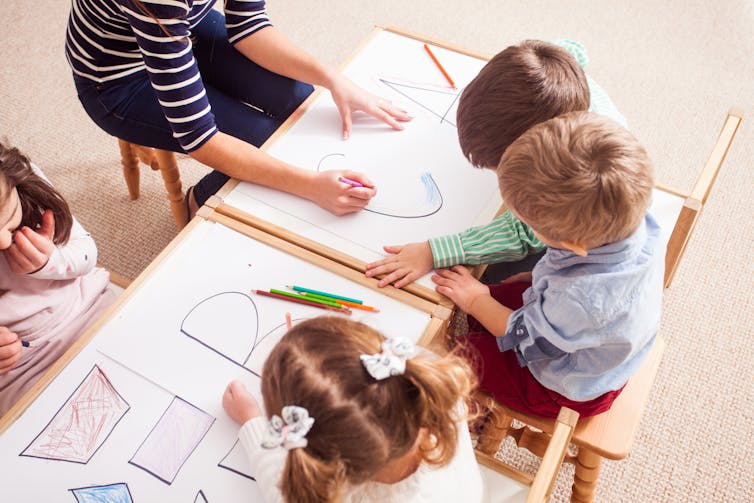
Andrew Whitehouse, The University of Western Australia and David Trembath, Griffith University
Australian’s first national guideline outlining the best ways of providing clinical support to autistic children and their families will be launched in Canberra today.
The guideline, which we co-authored with others, represents a landmark moment for autism in Australia. It is the culmination of a decades-long effort to build better evidence into clinical practice for autistic children.
For the first time, families of children with autism will have a clear description of what is and what is not safe and effective clinical practice, and a roadmap to empower their choices.
Autism in Australia
Autism became a formal diagnosis in Australia with the introduction of the third edition of the Diagnostic and Statistical Manual in 1980. But it was not until 1994 it was diagnosed in large numbers. Today, autism is diagnosed in more than 1% of people.
The most common types of therapies or supports for autistic children are focused on supporting their learning, participation, and wellbeing. This might involve directly teaching the child learning strategies, or changing the environment around the child. For many children, these therapies are used at the same time as prescribed medication.
There is good evidence to underpin the safety and effectiveness of many such therapies. However, like all areas of health and medicine, it can be hard to ensure measures are rolled out in the same way in different settings and locations. This can lead to confusion for children and families, and expose them to clinical therapies that may be ineffective or harmful.
With the increased focused on evidence-based medicine over the past two decades, there have been important steps taken to provide better guidance to clinicians and policymakers about what represents good practice. However, until now there hasn’t been an evidence-based guide they can refer to that brings together international expertise and research evidence.
84 recommendations
We developed the new guideline at the Autism CRC – established in 2013 as the world’s first national, cooperative research effort focused on autism across the lifespan. It brought together a group of researchers, clinicians, and autistic people, who consulted with more than 1,000 community members.
These community voices were then combined with evidence from three systematic reviews of international research to develop 84 recommendations.
The recommendations are presented as statements that describe key elements of practice. Clinicians follow these to deliver evidence-based therapies. Some examples are:
- Practitioners should have relevant qualifications, be regulated, work within their scope of practice with appropriate supervision, and engage in continuing professional development
- practitioners should engage in open and regular communication with other practitioners, the child’s educators, and other service providers, with appropriate consent, to ensure supports are coordinated
- practitioners should ensure the child and family understand the rationale for recommended supports, along with potential benefits, costs, and alternative options.
The recommendations will help clinicians work with children and families to set therapy goals, select and deliver the most appropriate therapies to meet those goals, and then monitor therapies to ensure they are safe and effective.

What does the guideline mean for clinicians and families?
Providing therapies to autistic children can be complex, and involves the consideration of many factors. A therapy approach that may be appropriate for one autistic child, may be quite unsuitable for another child.
For example, some children may receive benefit from learning to talk with the help of a technology device. Other children may not benefit from this approach and learn best through verbal conversations only.
Similar considerations may apply to where a therapy is delivered (in a clinic, in the home, or in the community), how it is delivered (individually or in a group), and through what means (in person or via screen or telephone).
The new guideline gives a step-by-step process to help clinicians consider these factors in a logical and systematic way. This helps clinicians understand the unique factors of each child and their family, and to turn this knowledge into the most effective plan to support them.
So for families, the guideline represents a roadmap for engaging with therapy.
Preventing parents from being overwhelmed
At the time of a child’s autism diagnosis, the amount of information for families to understand and act upon can be overwhelming. Many families are very well supported by the clinicians they are seeing, but many also resort to searching the internet to find answers to their questions.
The guideline will help families understand what evidence-based therapy looks like, and how they can use this information to navigate the best pathway for their child.
We hope this will inform and empower families to feel confident making decisions in the best interests of their child’s learning, participation and wellbeing.
What to watch for next
While the guideline is not mandatory, it has important implications for government systems such as the National Disability Insurance Scheme (NDIS).
At a time when there is concern about how the NDIS can best support its participants, this new document provides evidence-based guidance.
The best next step would be for the NDIS to adopt this guideline. This would give NDIS participants and their families a much better chance of supporting autistic children to flourish. ![]()
Andrew Whitehouse, Bennett Chair of Autism, Telethon Kids Institute, The University of Western Australia and David Trembath, Associate Professor, Menzies Health Institute Queensland, Griffith University
This article is republished from The Conversation under a Creative Commons license. Read the original article.
see also
- https://www.uwa.edu.au/news/Article/2023/February/New-national-autism-guideline-will-finally-give-families-a-roadmap-for-therapy-decisions
- https://a4.org.au/node/2530, https://thewest.com.au/politics/support-dont-cure-kids-with-autism-new-guidelines-c-9771597
- https://www.miragenews.com/national-guideline-launched-to-support-autistic-948481/
- https://thesector.com.au/2023/02/17/rishworth-announces-australian-first-guideline-to-better-support-autistic-children/
- https://www.theaustralian.com.au/nation/politics/stop-trying-to-cure-autistic-kids-parents-told/news-story/8f0ff802fd6a1737d9124598f1497163